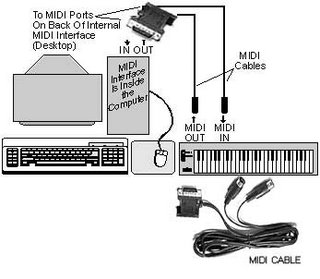Day 3
Simple Midi Setup
Trust me! Today this is a very easy process, as simple as connecting a cable modem, Windows is pretty sharp; it will make your life easy.
Back in 1993-95 installing midi devices was more or less like learning mathematical tables above 12, complicated. Today, required parts are widely available. However before going into it, let me be clear, I am going talk only from a PC perspective – Even today Apple MAC seems to be a diet pill for my wallet.
Requirements:
A PC with an maximum age limited to 7 years and that runs any version other than the dreaded Windows ME [ME=Must be Extinguished] or later. A sound blaster compatible sound card, PCs born 7 years ago should have a sound card; A GM midi keyboard or a controller, and an over the counter “PC-Midi cable”. This is called Game Port to Midi adapter which can be found in most computer or electronic shops. Finally the sequencer software, though I would be explaining concepts using Generic sequencer terms I suggest having Cakewalk Home studio. [No! Cakewalk does not pay me for this promo].
As explained before in earlier chapters, Midi traffic is one way road, hence in a simple midi setup there would be a Midi in that carries data to the PC, and Midi Out that sends data from the pc. Plug in the 15 pin Midi cable to the Game port, if you are gamer using joy stick, fear not! Most midi cables have adapters to hold both.
In our set up the controller and slave will be same person, what is this controller, an input device to the master, which would be sequencer software running in your pc.

From the picture to you can see how simple is to connect. Now let us get into some complexity, Install your sequencer software, before going deep into this; let me explain some basic terminologies, not found in books.
MIDI DEVICES: Sequencer software needs to know about all your midi devices. You are expected to select Midi devices; this can be found in the preferences or options. There would be 2 columns; Midi input to assign the input device and Midi out to assign the Midi out device. This can also be a Single to Multiple connections. Meaning, a sequencer can receive data from a single midi device and transmit midi data to many number of midi devices. This would make more meaning only if you have multiple midi devices, but in your case there should be only one, which would be your sound card. Cakewalk will automatically profile the midi devices.
PORT NUMBER: In simple terms, Port numbers are special channels through which the master and the slave communicate. Sequencer recognizes midi devices by assigning port numbers. Every slave gets a unique port number to receive data and every input device [the controller] gets a unique port number to transmit data. This is important, if you don’t understand it, take a deep breath and read this paragraph again.
In a midi farm, port numbers are very important. For the above simple midi setup, we would just have single port for the input and single port for the output, both numbers are exclusive but independent. If you are a network buff, this is just like the web server port number that can be closed and opened using a fire wall.
CHANNEL NUMBER: 1-16 MIDI channel numbers. Master can address slaves using these 16 channels on a given port number. There is no particular order here, user can pick channel 16 alone and dump the whole song on it, which never happens though. Something like dumping everything on single soup bowl.
Healthy practice would be to use one instrument per midi channel. Each device can handle 16 Channels only, however today there are keyboards and sound modules with dual or more Midi groups, like 32 midi channels split by 2 port numbers.
TRACK: - Track is an independent container that holds midi data. Music stored in a track moves from left to right. Technically a track can hold any number of midi channels and its related data. Meaning the entire composition can be dumped on to a single track, something like writing this whole article on single line. In most sequencers a track can address only one port. Meaning it can dump data to particular salve only. The general practice is to use Single Midi channel per track, and more than one track can be used for the same midi Channel + port number combination. Users can also force various parameters on a given track; This is the most Integral part of a sequencer.They are called track parameters which we will learn in next session.
All Rights Reserved (c) Srikanth Devarajan, Unauthorized copying or re-publishing of this article is prohibited, you have license to learn! And pass it on to others with the authors name intact. If you want to syndicate this, kindly contact me at srikanthD at gmail.
0 comments:
Post a Comment